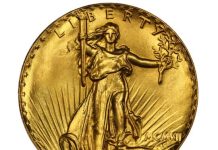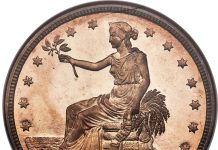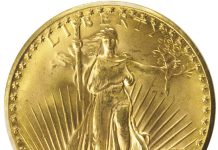 LOUSING UP THE FIRST SPOUSE SERIES
LOUSING UP THE FIRST SPOUSE SERIES
by Ed Reiter
Chester Alan Arthur was one of this country’s most fascinating presidents. After a middling career as an utterly undistinguished political hack, he was nominated for the vice presidency following a backroom deal in 1880—in the confident expectation that this would consign him to permanent obscurity.
Within a matter of months, an assassin’s bullet claimed the life of President James A. Garfield and placed the reins of power in Arthur’s hands—and to everyone’s surprise, he rose to the occasion by carrying out his duties with dignity and integrity no one ever imagined he possessed.
Sadly, our friends inWashingtonseem to have looked upon Arthur more as the disposable hack that he had been than the first-rate president he became. They did so by distorting the “First Spouse” coin that accompanies his presidential dollar into a billboard for misplaced political pandering.
I’m not a great admirer of the First Spouse program. As I wrote when this started five years ago, it makes little sense to strike base-metal coins honoring U.S. presidents and then produce bullion coins with half an ounce of gold apiece to showcase their first ladies. The U.S. Mint offers bronze medal duplicates of the First Spouse coins for far more affordable prices—so why make the coins at all, except to fatten the Mint’s hefty profits from selling all that gold for sizable markups.
In keeping with the Mint’s recent artistic output, the First Spouse coins have been predictably pedestrian up to now. Their designs have been dull but generally relevant—Abigail Adams penning a letter to John, for example, and Mary Todd Lincoln bringing books and flowers to wounded Union soldiers.
But now, on the First Spouse coin paired with Chester Arthur’s dollar, we find ourselves confronted with a woman and a theme that have little or nothing to do with either President Arthur or the precedents established by previous coins in the series.
Arthur’s wife, Ellen, died on Jan. 12, 1880, some 20 months before he became president. Four of his predecessors—Thomas Jefferson, Andrew Jackson Martin Van Buren and James Buchanan—also entered the nation’s highest office without a first lady. To keep the spouse series continuous, the Mint issued substitute gold coins. The obverse of each bore an image ofLibertytaken from a coin that circulated during the president’s term and the reverse depicted a scene from the president’s life.
An obviousLibertyportrait for Arthur’s substitute First Spouse coin would have been the one on the Liberty Head nickel, which made its debut in 1883, while he was in the White House. The reverse could have shown a nattily dressed Arthur at the opening of theBrooklynBridgeon May 24, 1883, or signing the Pendleton Civil Service Reform Act earlier that year. That, after all, is the piece of legislation for which he is best remembered and most universally hailed.
But in authorizing the program, Congress decreed that the First Spouse coin tied to Chester Arthur would be different. There would be no likeness ofLibertybased on a coinage portrait in use at the time he served. There would be no reverse vignette showing a pertinent scene from the president’s life.
Instead, we would get a coin “incorporating the name and likeness of Alice Paul, a leading strategist in the suffrage movement, who was instrumental in gaining women the right to vote upon the adoption of the 19<superscript>th</superscript> amendment and thus the ability to participate in the election of future presidents.”
Never mind that civil service reform, not women’s suffrage, was the dominant issue of Chester Arthur’s presidency. Never mind that Alice Paul didn’t emerge as a women’s rights leader until the 20<superscript>th</superscript> century’s second decade and the 19<superscript>th</superscript> amendment didn’t become law until 1920.
The loose connection? Alice Paul was born in 1885, while Arthur was in the White House. Less than eight weeks passed between her birth on Jan. 11 and Arthur’s last day in office, March 4. So she was more “last baby” than first lady.
The linkage is preposterous—akin to using Jefferson’s First Spouse coin to spotlight the evils of industrial trusts, orJackson’s to focus on Prohibition.
This is a misguided effort to curry feminists’ favor. Alice Paul might very well deserve a coin—but this is not the one.











